PbS QD-Coated Si Micro-Hole Array/Graphene vdW Schottky Near-Infrared Photodiode for PPG Heart Rate Measurement
Abstract
:1. Introduction
2. Materials and Methods
3. Results and Discussion
4. Conclusions
5. Patents
Author Contributions
Funding
Institutional Review Board Statement
Informed Consent Statement
Data Availability Statement
Acknowledgments
Conflicts of Interest
References
- Tao, A.; Yao, T.; Jiang, Y.; Yang, L.; Yan, X.; Ohta, H.; Ikuhara, Y.; Chen, C.; Ye, H.; Ma, X. Single-dislocation Schottky diodes. Nano Lett. 2021, 21, 5586–5592. [Google Scholar] [CrossRef]
- Chang, K.E.; Yoo, T.J.; Kim, C.; Kim, Y.J.; Lee, S.K.; Kim, S.Y.; Heo, S.; Kwon, M.G.; Lee, B.H. Gate-controlled graphene–silicon Schottky junction photodetector. Small 2018, 14, 1801182. [Google Scholar] [CrossRef] [PubMed]
- Yang, W.; Chen, J.X.; Zhang, Y.; Zhang, Y.J.; He, J.H.; Fang, X.S. Silicon-compatible photodetectors: Trends to monolithically integrate photosensors with chip technology. Adv. Funct. Mater. 2019, 29, 1808182. [Google Scholar] [CrossRef]
- Liu, C.; Guo, J.; Yu, L.; Li, J.; Zhang, M.; Li, H.; Shi, Y.; Dai, D. Silicon/2D-material photodetectors: From near-infrared to mid-infrared. Light Sci. Appl. 2021, 10, 123. [Google Scholar] [CrossRef] [PubMed]
- Kang, Z.; Ma, Y.; Tan, X.; Zhu, M.; Zheng, Z.; Liu, N.; Li, L.; Zou, Z.; Jiang, X.; Zhai, T.; et al. MXene–silicon van der Waals heterostructures for high-speed self-driven photodetectors. Adv. Electron. Mater. 2017, 3, 1700165. [Google Scholar] [CrossRef]
- Wan, X.; Xu, Y.; Guo, H.; Shehzad, K.; Ali, A.; Liu, Y.; Yang, J.; Dai, D.; Lin, C.; Liu, L.; et al. A self-powered high-performance graphene/silicon ultraviolet photodetector with ultra-shallow junction: Breaking the limit of silicon? NPJ 2D Mater. Appl. 2017, 1, 4. [Google Scholar] [CrossRef]
- Song, W.; Liu, Q.; Chen, J.; Chen, Z.; He, X.; Zeng, Q.; Li, S.; He, L.; Chen, Z.; Fang, X. Interface engineering Ti3C2 MXene/silicon self-powered photodetectors with high responsivity and detectivity for weak light applications. Small 2021, 17, 2100439. [Google Scholar] [CrossRef] [PubMed]
- Song, L.; Xu, E.; Yu, Y.; Jie, J.; Xia, Y.; Chen, S.; Jiang, Y.; Xu, G.; Li, D.; Jie, J. High-barrier-height Ti3C2Tx/Si microstructure Schottky junction-based self-powered photodetectors for photoplethysmographic monitoring. Adv. Mater. Technol. 2022, 7, 2200555. [Google Scholar] [CrossRef]
- Ollearo, R.; Ma, X.; Akkerman, H.B.; Fattori, M.; Dyson, M.J.; van Breemen, A.J.J.; Meskers, S.C.J.; Dijkstra, W.; Janssen, R.A.J.; Gelinck, G.H. Vitality surveillance at distance using thin-film tandem-like narrowband near-infrared photodiodes with light-enhanced responsivity. Sci. Adv. 2023, 9, eadf9861. [Google Scholar] [CrossRef]
- Simone, G.; Tordera, D.; Delvitto, E.; Peeters, B.; van Breemen, A.J.J.M.; Meskers, S.C.J.; Janssen, R.A.J.; Gelinck, G.H. High-accuracy photoplethysmography array using near-infrared organic photodiodes with ultralow dark current. Adv. Opt. Mater. 2020, 8, 1901989. [Google Scholar] [CrossRef]
- Nowara, E.M.; Marks, T.K.; Mansour, H.; Veeraraghavan, A. near-infrared imaging photoplethysmography during driving. IEEE Trans. Intell. Transp. Syst. 2022, 23, 3589–3600. [Google Scholar] [CrossRef]
- Zhang, H.; Cui, Y.; Lu, M.; Yang, Q.; Feng, J.; Chen, S.; Yang, X.; Xu, G.; Yu, Y. Self-filtered NIR photodetectors based on silicon micro-holes array for stable heart rate monitoring. IEEE Electron Device Lett. 2022, 43, 2129–2132. [Google Scholar] [CrossRef]
- Charlton, P.H.; Kyriacou, P.A.; Mant, J.; Marozas, V.; Chowienczyk, P.; Alastruey, J. Wearable Photoplethysmography for cardiovascular monitoring. Proc. IEEE 2022, 110, 355–381. [Google Scholar] [CrossRef] [PubMed]
- Sun, Y.; Thakor, N. Photoplethysmography revisited: From contact to noncontact, from point to imaging. IEEE Trans. Biomed. Eng. 2016, 63, 463–477. [Google Scholar] [CrossRef]
- Spigulis, J.; Gailite, L.; Lihachev, A.; Erts, R. Simultaneous recording of skin blood pulsations at different vascular depths by multi-wavelength photoplethysmography. Appl. Opt. 2007, 46, 1754–1759. [Google Scholar] [CrossRef] [PubMed]
- Xu, H.; Liu, J.; Zhang, J.; Zhou, G.; Luo, N.; Zhao, N. Flexible organic/inorganic hybrid near-Infrared photoplethysmogram sensor for cardiovascular monitoring. Adv. Mater. 2017, 29, 1700975. [Google Scholar] [CrossRef] [PubMed]
- Mi, L.; Chang, Y.; Zhang, Y.; Xu, E.; Jiang, Y. Hybrid perovskite exchange of PbS quantum dots for fast and high-detectivity visible–near-infrared photodetectors. J. Mater. Chem. C 2021, 9, 417–438. [Google Scholar] [CrossRef]
- Mi, L.; Wang, H.; Zhang, Y.; Yao, X.; Chang, Y.; Li, G.; Lei, C.; Li, G.; Jiang, Y. Converting electrical conductivity types in surface atomic-ligand exchanged PbS quantum dots via gate voltage tuning. J. Alloys Compd. 2017, 699, 866–873. [Google Scholar] [CrossRef]
- Mi, L.; Wang, H.; Zhang, Y.; Yao, X.; Chang, Y.; Li, G.; Li, G.; Jiang, Y. High performance visible–near-infrared PbS-quantum-dots/indium Schottky diodes for photodetectors. Nanotechnology 2017, 28, 055202. [Google Scholar] [CrossRef]
- Lv, P.; Zhang, X.; Zhang, X.; Deng, W.; Jie, J. High-sensitivity and fast-response graphene/crystalline silicon Schottky junction-based near-IR photodetectors. IEEE Electron Device Lett. 2013, 34, 1337–1339. [Google Scholar] [CrossRef]
- Xiang, D.; Han, C.; Hu, Z.; Lei, B.; Liu, Y.; Wang, L.; Hu, W.; Chen, W. Surface transfer doping-induced, high-performance graphene/silicon Schottky junction-based, self-powered photodetector. Small 2015, 11, 4829. [Google Scholar] [CrossRef]
- Li, X.; Zhu, M.; Du, M.; Lv, Z.; Zhang, L.; Li, Y.; Yang, Y.; Yang, T.; Li, X.; Wang, K.; et al. Graphene: High detectivity graphene-silicon heterojunction photodetector. Small 2016, 12, 549. [Google Scholar] [CrossRef]
- Adhikari, S.; Biswas, C.; Doan, M.H.; Kim, S.T.; Kulshreshtha, C.; Lee, Y.H. Minimizing trap charge density towards an ideal diode in graphene-silicon Schottky solar cell. ACS Appl. Mater. Interfaces 2019, 11, 880–888. [Google Scholar] [CrossRef]
- Periyanagounder, D.; Gnanasekar, P.; Varadhan, P.; He, J.H.; Kulandaivel, J. High performance, self-powered photodetectors based on a graphene/silicon Schottky junction diode. J. Mater. Chem. C 2018, 6, 9545–9551. [Google Scholar] [CrossRef]
- Yin, J.; Liu, L.; Zang, Y.; Ying, A.; Hui, W.; Jiang, S.; Zhang, C.; Yang, T.; Chueh, Y.L.; Li, J.; et al. Engineered tunneling layer with enhanced impact ionization for detection improvement in graphene/silicon heterojunction photodetectors. Light Sci. Appl. 2021, 10, 113. [Google Scholar] [CrossRef]
- Wang, L.; Luo, H.; Zuo, H.; Tao, J.; Yu, Y.; Yang, X.; Wang, M.; Hu, J.; Xie, C.; Wu, D.; et al. Highly sensitive narrowband si photodetector with peak response at around 1060 nm. IEEE Trans. Electron Devices 2020, 67, 3211–3214. [Google Scholar] [CrossRef]
- Wang, L.; Li, Z.; Li, M.; Li, S.; Lu, Y.; Qi, N.; Zhang, J.; Xie, C.; Wu, C.; Luo, L.B. Self-powered filterless narrow-band p–n heterojunction photodetector for low background limited near-infrared image sensor application. ACS Appl. Mater. Interfaces 2020, 12, 21845–21853. [Google Scholar] [CrossRef]
- Yu, Y.; Li, Z.; Lu, Z.J.; Geng, X.; Lu, Y.; Xu, G.; Wang, L.; Jie, J. Graphene/MoS2/Si nanowires Schottky-NP bipolar van der waals heterojunction for ultrafast photodetectors. IEEE Electron Device Lett. 2018, 39, 1688–1691. [Google Scholar] [CrossRef]
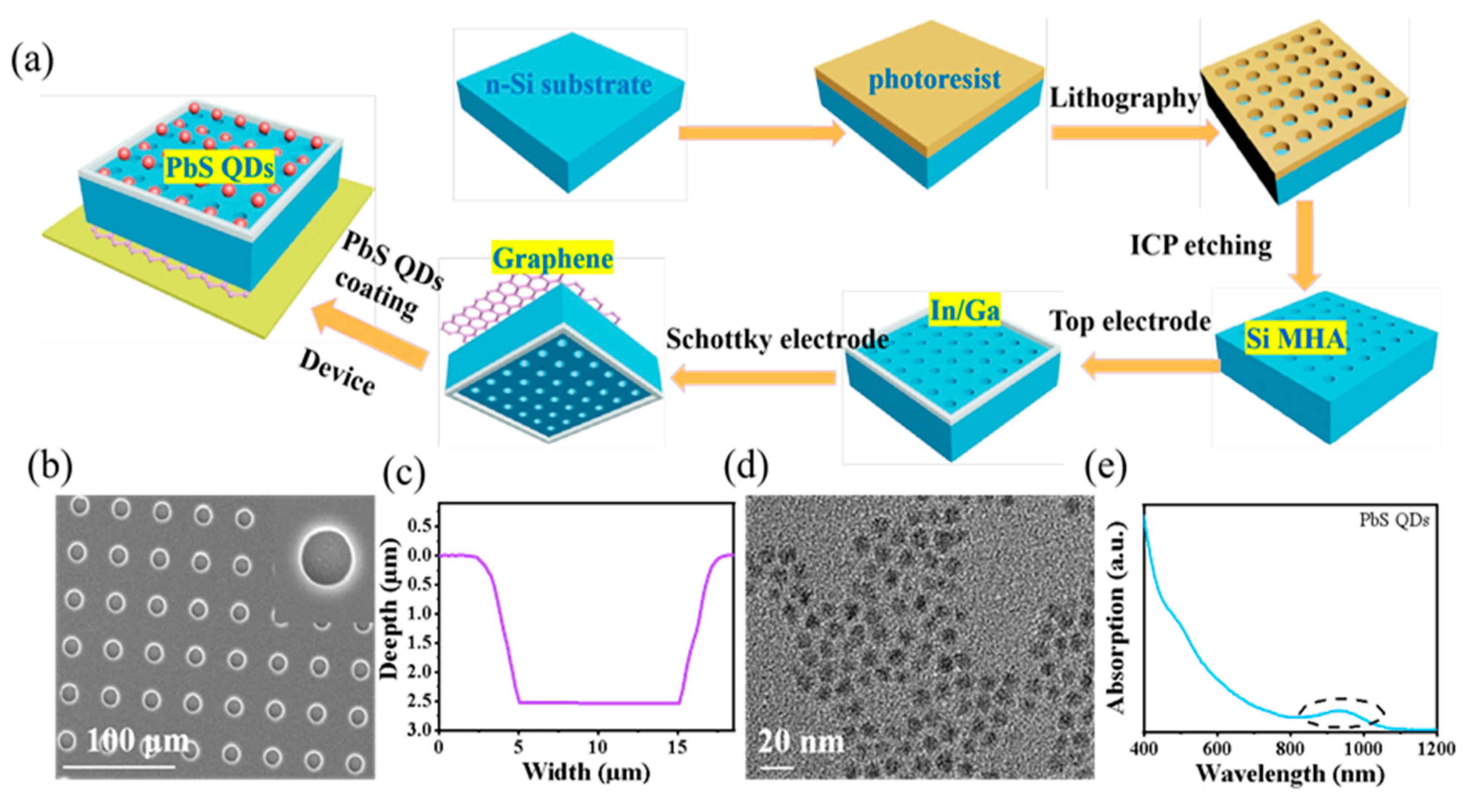
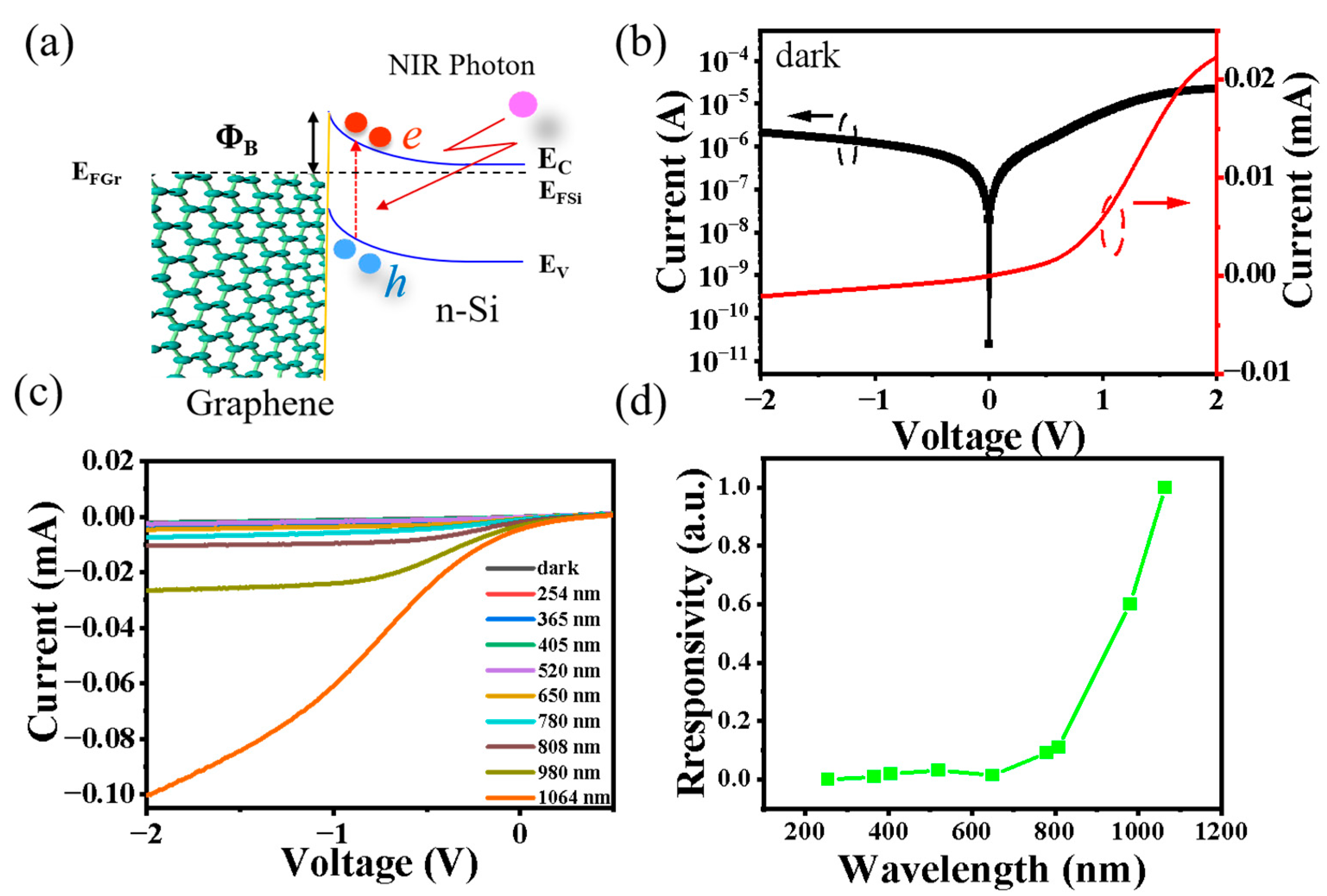
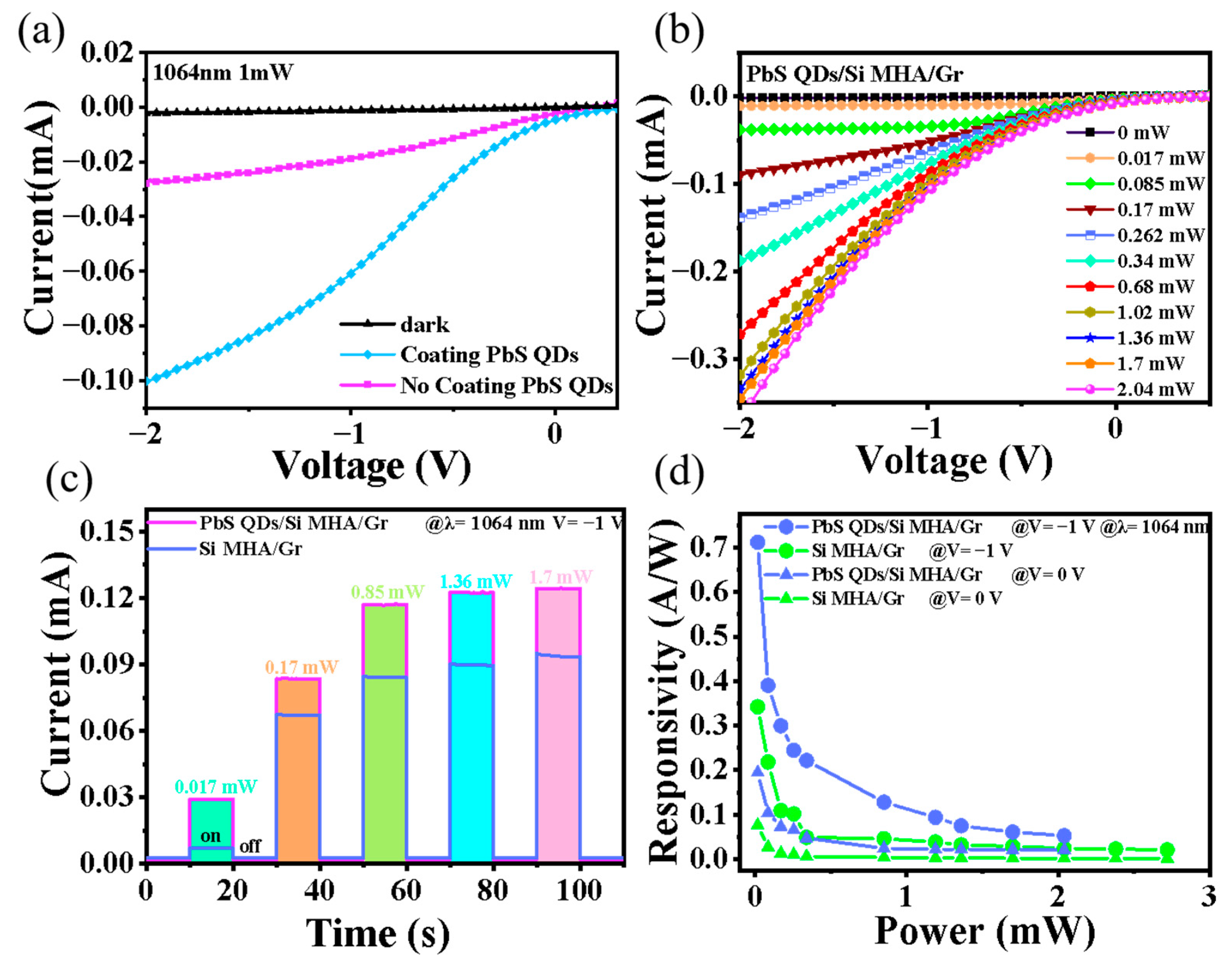
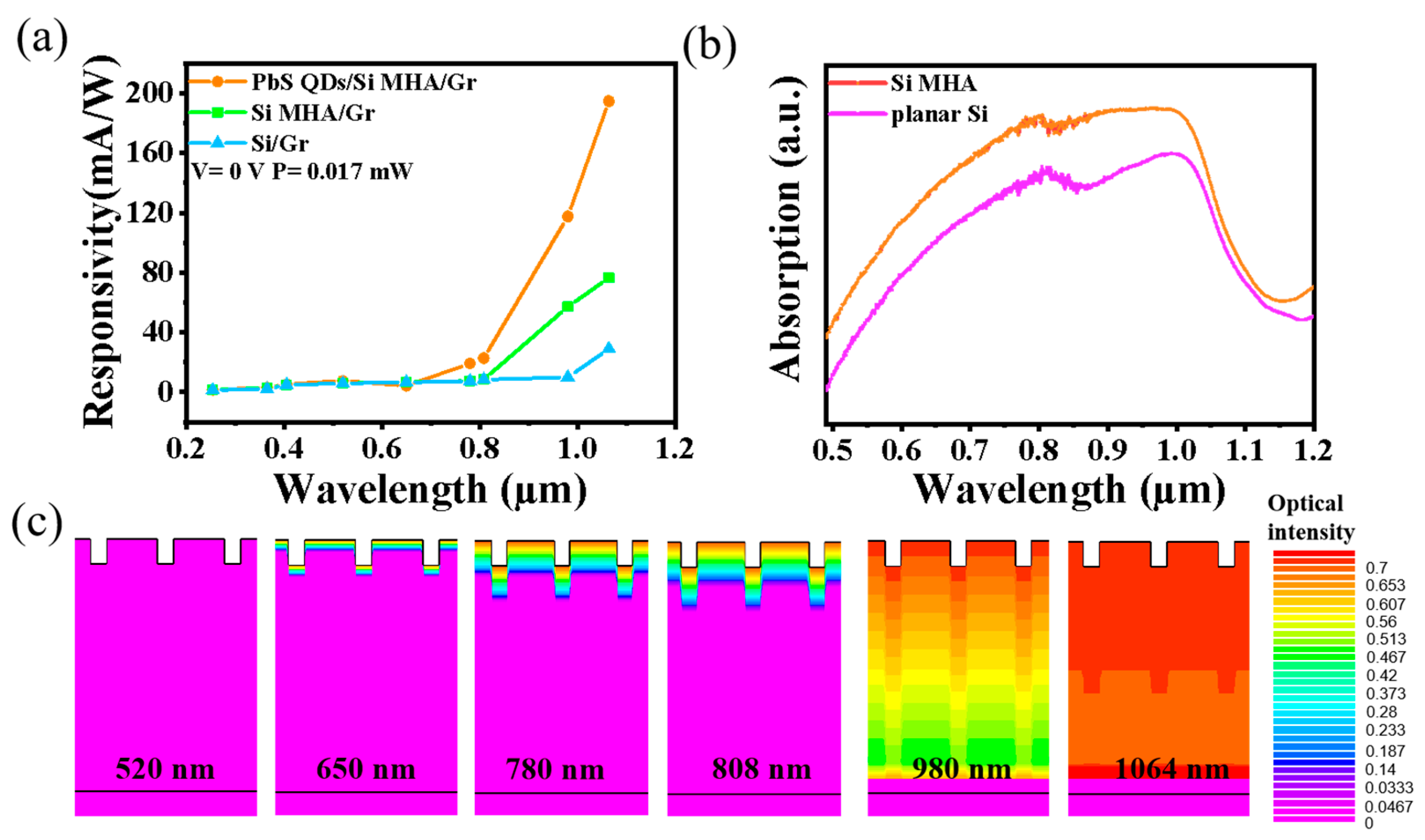

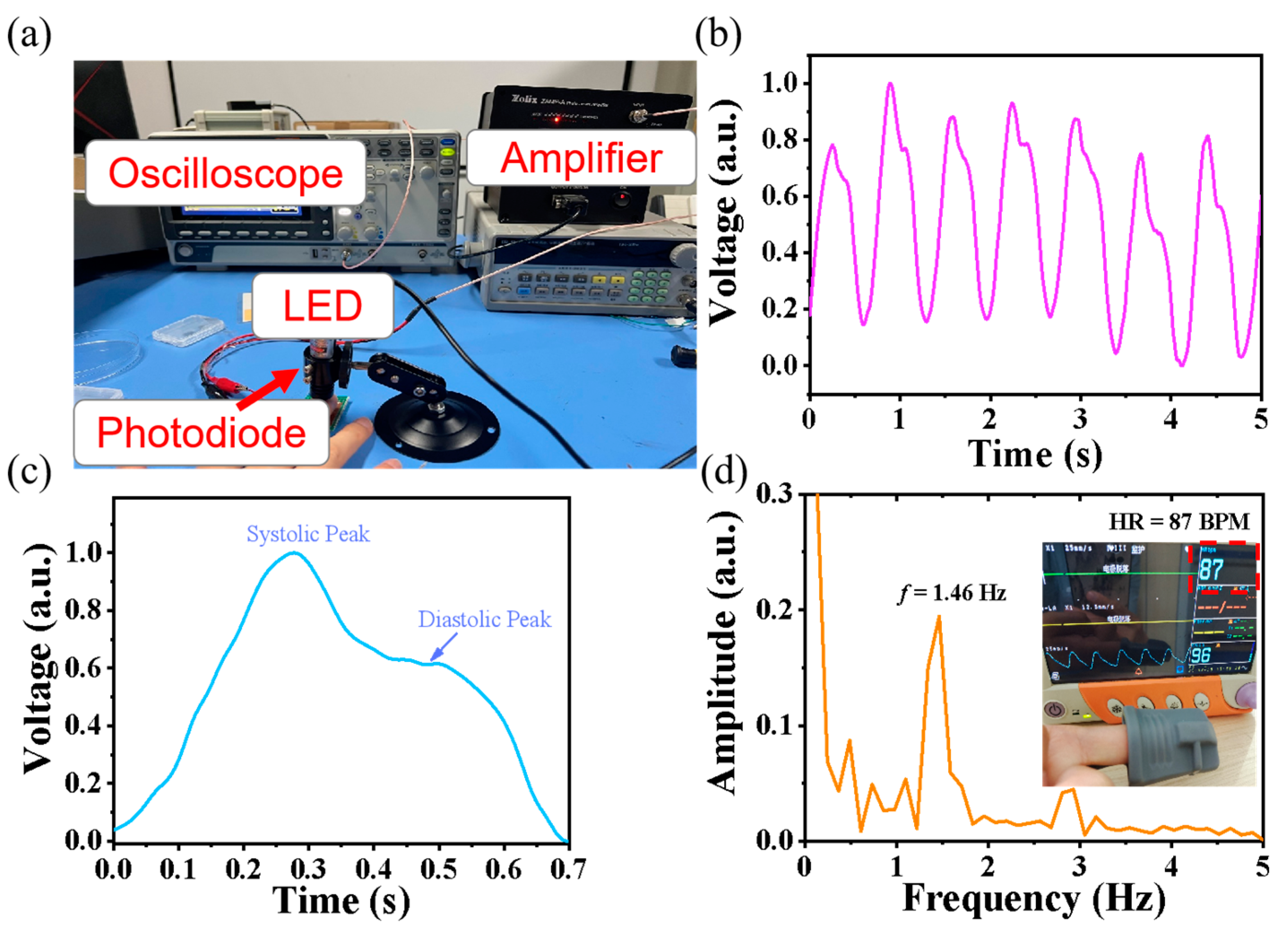
Disclaimer/Publisher’s Note: The statements, opinions and data contained in all publications are solely those of the individual author(s) and contributor(s) and not of MDPI and/or the editor(s). MDPI and/or the editor(s) disclaim responsibility for any injury to people or property resulting from any ideas, methods, instructions or products referred to in the content. |
© 2023 by the authors. Licensee MDPI, Basel, Switzerland. This article is an open access article distributed under the terms and conditions of the Creative Commons Attribution (CC BY) license (https://creativecommons.org/licenses/by/4.0/).
Share and Cite
Xu, M.; Cui, Y.; Zhang, T.; Lu, M.; Yu, Y. PbS QD-Coated Si Micro-Hole Array/Graphene vdW Schottky Near-Infrared Photodiode for PPG Heart Rate Measurement. Sensors 2023, 23, 7214. https://doi.org/10.3390/s23167214
Xu M, Cui Y, Zhang T, Lu M, Yu Y. PbS QD-Coated Si Micro-Hole Array/Graphene vdW Schottky Near-Infrared Photodiode for PPG Heart Rate Measurement. Sensors. 2023; 23(16):7214. https://doi.org/10.3390/s23167214
Chicago/Turabian StyleXu, Mingyuan, Yinghao Cui, Tao Zhang, Mengxue Lu, and Yongqiang Yu. 2023. "PbS QD-Coated Si Micro-Hole Array/Graphene vdW Schottky Near-Infrared Photodiode for PPG Heart Rate Measurement" Sensors 23, no. 16: 7214. https://doi.org/10.3390/s23167214
APA StyleXu, M., Cui, Y., Zhang, T., Lu, M., & Yu, Y. (2023). PbS QD-Coated Si Micro-Hole Array/Graphene vdW Schottky Near-Infrared Photodiode for PPG Heart Rate Measurement. Sensors, 23(16), 7214. https://doi.org/10.3390/s23167214




